American Sabbatical 82: 4/1/97
Tampa Fool's Day
4/1.. Tampa Fool Day.
It was blessedly cool Tuesday morning in St. Pete. Trouser weather even. They’re getting
buried in bad jokes in Boston, three feet deep, but we’re just
grinning in the 70’s. We'd made our bed just crosstown from the
Dali Museum, and that was our first ambition. Seemed right for
a Fool’s Day.
First we had to navigate a middle class black neighborhood. There
have been lots of them in Florida, usually just outside the city
centers, and they’re as house-proud and trim as any other suburb.
This one seemed to favor bath-tile exteriors and cement kitsch,
along with white Hondas and Nissans. Is ghettoization more noticeable
in Florida? You bet. The geezers are all walled off in gated communities,
with the golf courses.
Salvador Dali didn’t winter his circus in St. Pete, or anything.
The museum was a civic deal with a collector from Cleveland who
couldn’t convince Carthage on Cayuhoga that a permanent connection
with the mad Spaniard was worth public investment. St. Petersburg
leapt into the breach.
The brand spanking museum sits on the brink of a marina filled
with megabucks of floating follies, alongside the flight path
for ST. P Municipal. As we disembarked the FujiFilm Blimp circled
overhead, and a red biplane did touch and goes. All quite bizarre.
As you’d expect.
(Memo #74)
April 1 Dali Museum
Who? Spanish painter Salvador Dali
What? museum based on personal collection
Where? St. Petersburg, Florida
When? now
How? St. Petersburg wooed collectors
Topics: surrealism, Dali, art collectors-patrons, symbolism, Freudian
psychology
Questions: Why is there a Salvador Dali Museum in St. Petersburg,
Florida? What themes and symbols does Dali use? What is the role
of an art patron and collectors like the Morses?
|
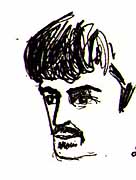
Young Dali
|
Dripping clocks is the image most associated with surrealist artist
Salvador Dali, fantastic landscapes of sere hills and stark trees
that house real objects and dream figures. He is perhaps the most
widely known surrealist painter. It turns out that he could be
known as an impressionist, sculptor, illustrator, symbolist. He
worked in every style, scale, and medium: metal, oil, watercolor,
lithograph, photograph, holograph, jewelry, stage set. A superb
collection of work is displayed in the Dali Museum in St. Petersburg,
Florida (95 oils, 100+ watercolors, graphics, 6 of his “masterworks”
etc).
Why St. Petersburg? Dali never worked or lived there, he didn’t
study there. It WAS Spanish territory centuries ago, but... The
answer is interesting. Eleanor and A. Reynolds Morse were passionate
collectors of Dali’s art and his lifelong friends. They bought
his art, documented his thinking, photographed his homeland, translated
his lectures. They came from Cleveland (!) and began a small Dali
museum there which they outgrew. They were determined to keep
their collection together, housed in its own museum space. No
major museum was willing to do this. A St. Petersburg businessman
learned of the collection and started the movement to have a Dali
museum in St. Petersburg. It was successful. The collection was
wooed by the city and state fathers who built the special museum.
It is a lovely museum, a simple modern square on the water.
The museum has Dali’s first oil (an impressionist landscape),
painted when he was 13, and a range of work from every period
of his life. The academics divide his life into Early Works (1914-27),
Transitional period (1928), Surrealism (1929-1940), Classical
Period (1943-89), and Masterworks (1948-70).
The museum makes a good case for keeping an artist’s work together.
Something very distinctive happens when you view work after work
by an artist and see the development of technique and symbolism
as s/he ages. Your eye begins to spot recurrent themes and figures.
You see something in a painting and walk back two galleries to
find it in its embryonic stage in another painting. The staff
knows the artist in great depth, living with this extensive collection
and the knowledge gained from the Morses. Both the guides' commentary
and the written text are rich and detailed. There are the icons,
of course, but set within a context of his life and imagery.
The surrealists attest to the impact of Sigmund Freud on our century
and our thought. Not only did Freud herald childhood as the key
period in psychic development, but he stressed the significance
of dreams and the unconscious as manifestations of inner drives
and desires and needs. The surrealists were committed to mining
their own inner worlds for artistic material; they painted their
dreams and visions, memories, and reminiscences. The commentary
defines Dali’s “paranoic-critical method” as the use of his personal
fears and dreams and memories visually.
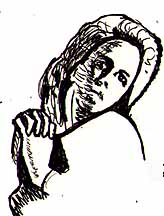
Gala
|
Dali’s art show the incredible mix of images and themes that lived
in his unconscious. There are bits of a very real landscape -
the towns of Figueres and Port Llagat in Catalonia where Dali
lived almost all his life. The hills and boats, docks and houses
in Dali’s work can be identified. The Morses photographed some
sites that appear totally realistically, if piecemeal, in specific
paintings. His wife Gala (formerly the wife of French poet Paul
Eluard) is his muse; her face appears on madonnas and saints and
anonymous female figures. |
Dali incorporates images from artists he revered (Vermeer, Velasquez,
Millet), from popular culture (the matador, sunning tourists,
Alice Cooper), from history (Columbus, Popes, Don Quixote), from
Catholicism (crosses and Christ figures), from Catalan life (the
distinctive red hat, the “barentina”), and local legends. One
recurrent figure is a fly, often painted in serried rows, representing
the flies sent by a Catalan saint to rout an enemy army. The details
of his own life are painted - the death of a brother (also Salvador)
nine months before he was born, his childhood nurse, his furniture.
His specific dream figures are here, like his Galuchka, a fictitious
Russian girl who appears as “The Girl with Curls”. Each canvas
is rich in personal matter.
Dali was a highly disciplined draftsman and his paintings were
developed from intricate grids. You become aware as you move through
the museum of his ability to draw - the detailed bodies and hills,
fruit and broken bridges.There is a quite classic portrait of
a girl’s back (Portrait of My Sister). He loved to use montage
- so that a face is composed of people’s portraits. He also had
a wicked sense of humor and love for the absurd. His small statue
“Venus de Milo with Drawers” is hilarious, breasts and belly drawers
with graphic drawer pulls. It is bronze painted to look like plaster.
Dali is quoted as saying this piece “illustrates a certain complacency
in smelling the narcissistic odor of each of our drawers”. There
certainly is a narcissistic tone to the museum (was Dali mocking
himself or the Morses?).
Dali went to art school and mined art history for images. He incorporated
the symbols and news of his century. He played with newly emerging
technology like the holograph. He tried his hand at many crafts
- from illustration to set design. The culminations of his art
are his “Masterworks”, 18 huge and detailed canvases that he painted
after 1949. Each canvas took a year or more to complete and has
a year’s worth of images.
“The Discovery of America by Christopher Columbus” has layer upon
layer of shape and symbols - repeated crosses that become swords,
ranks of spears that become a grid for a crucifixion, realistic
human figures with flags, Popes and Christs, Gala in a supplicating
pose as a woman saint. In “Hallucinogenic Toreador” repeated images
of Venus de Milo form the visual illusion of the toreador’s face.
An abstract bull drips blood that becomes a lovely blue lake with
a modern sunbather floating on a plastic raft (he loathed the
tourists at a nearby Club Med!). A realistic arena frames the
top.
|
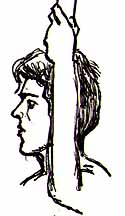
From Discovery
|
Dali was a showman whose life and persona were as surreal as his
paintings. He affected long eloquent moustaches, capes and wild
colors, and extreme expressions in photographs. Everyone has seen
his wildman image. He showcased his individuality, dressing in
exotic clothes even as a child (perhaps to eradicate the shade
of his dead brother to whom he was frequently compared). Photographs
show that he was a breathtaking young man with magnetic gaze.
His life and art were equally colorful. It’s somehow fitting that
this museum nearly abuts the memorials of Ringling and Disney.
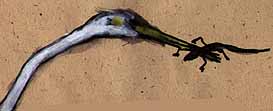
Lizard Eater
|
We toured the museum on April Fool’s. I ran into Sally Mackenzie’s
stepson from Bowdoinham inside. Outside I admired a sculpted egret
for several minutes before it winked and continued on its hunt
for lizards. The Fuji film blimp cruised overhead and a bright
red biplane buzzed by. It all seemed appropriately Dali-esque. |
4/1.. cont.
I’ve got a sore spot about the cult of personality in the arts. I believe it’s what
the art does, not who did it, that’s important. But, can 50 million
readers of People Magazine be wrong? Isn’t every petty detail of artistic celebrity more
valuable than experiencing the work itself? Of course it is..
to the dealers and museum curates.
Dali is the worst case example. One of the century’s great self-promoters
and showmen. It’s a wonder these paintings aren’t down in the
Ringling Museum alongside the circus Rubenses. You can forgive
Dali, of course. One look at photographs of him as a young man
show what a strikingly beautiful creature he was. He must have
turned heads wherever he went. So dramatic presentation was a
genetic gift. And self-promotion is the only alternative to subsistence
in the arts, in any century. Just read Cellini’s autobio and you’ll
see that the Renaissance artists invented this game of hype. We
should applaud the Dalis as great showmen, and salesmen.
|

|
The trouble is that the hype blinds us to their art. I have trouble
seeing past the banner headlines in museums. The work of GREAT
ARTISTS comes with so much baggage that I get run down by the
porter. Either the image of a great painting is so familiar that
it’s almost impossible to actually SEE it afresh, in the flesh,
or the fame of the artist creates such intellectual expectations
that I’m thinking references when I should just be looking. The
“museum quality” thing isn’t helped by the overbearing scholasticism
in the mausoleums, either. There’s so much text on the walls you
wonder if anyone can think for themselves.
I try NOT to read the labels in museums. I said TRY. Our compulsion
to caption experience is basic to the beast, however. Or it was
drummed into us by scholastic pedants. At least I won’t look at
the words first. In the Dali Museum the texts were actually clear
and to the point, but the work tells the tale. And to see a massed
retrospective of any artist is fascinating. In our age of self-absorption,
an artist who perfects the representation of his dreams, who turns
the material details of his world into a grand symbolism, has
to be honored as a prophet. Or reviled.
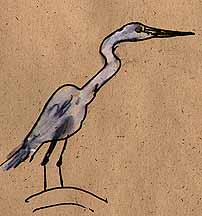
Egret
|
The surrealism of the 30s and 40s looks so dated now. Like the
nightmare of those times. And it’s the late works, those huge
canvases with floating Christs and draped Marys, and the child
Columbus setting foot on America, which are most compelling. Dali’s
latter day tricks with holographic paintings are less effective,
now there are billboards along the highway using the same surprise
effect. |
It's Dali’s need to shock us, disorient us, which is his ultimate
trademark, and familiarity grounds the jolt. You are left admiring
the technique, which will always be powerful, but you wonder if
there was any substance to the message once stripped of its visceral
punch. Monumentalism is a cheap trick, without content.. and are
the private nightmares of famous artists worth $8 per to contemplate,
if they don’t mirror some larger truth? The big Jesus paintings
come closest to jumping over the years, for me, but seeing them
in Smithsonian, or the like, had discharged too much of the juice.
| The small carvings that so moved me in Sarasota were all of unknown
attribution. Which is much to be preferred. The artists are invisible.
All that remains is the power of the work. Hope they ate ok. |
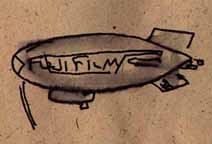
|
As usual I was out in the air breathing deep long before Peggy.
Along the marina side of the museum an egret was stalking lizards
in the hedge, and oblivious to people two yards away. I followed
him along for 20 minutes, enraptured by his movements, sketching
madly. He would lift his pencil-thin legs, flexing his toes before
setting them down, stepping gracefully trough the tall grass.
All 18 inches of his serpentine neck would wiggle eagerly as he
focused on the 10 inch lizards. Then strike. He’d squeeze the
lizard amidships for a moment, then swallow him whole. And go
stalking again. A four foot tall lizard-killer on the prowl. Very
surreal.
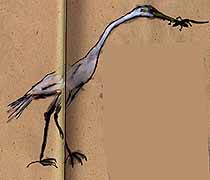
Surreal Encounter
|
Peggy was encountering one of our neighbors from Bowdoinham inside.
Peter MacKenzie, stepson to her ex-partner. Son of the marriage
Peggy played matchmaker to. Peter is making a Florida tour with
his college a capella group, singing the National Anthem at a
hockey playoff tonight. More surrealism.
|
Time for Tampa. Our navigator is still hot for museum art, in
particular the Tampa M of A's antiquities, items which unfailingly
stir her to draw. Dali has given me a dose of museumitis, so I
go off to capture the colorful office towers of downtown Tampa.
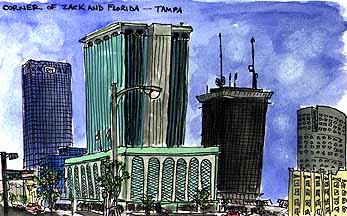
Tampa
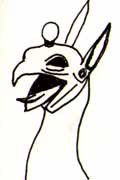
|
Pretty sterile town, folks. The kind of place where the streets
are almost empty, the homeless keep moving, and the meter cops
are unforgiving. I was parked across from the Tampa Electric walkup
windows, where people were doling out greenbacks to keep their
lights on. One poor woman stood at the window reciting the litany
of her impecuniarity loud enough for me to hear. When she turned
around a cop was ticketing her car, and all her tears and protestations
didn’t move him one wit. I kept feeding quarters into the meter.
The technicolor buildings are eyecandy, though. Maybe everyone
is indoors in an airconditioned daydream. |
| By mid-afternoon even Peggy has had enough culture, and we eagerly
return to the joys of the long mall. The consuming frenzy is heightened
by road construction north of Tampa, and we endure an hour of
asphalt fumes and shoppers’ aggro before we get spit out of the
maw. I’ve neglected to observe a special feature of Florida’s
miracle miles: geriatric outlets. The Knee Place. Pedopedics.
Ambulatory Devices. New Teeth: $100. Private MRI scanning. And
the highway hospitals are the biggest institutions in sight. The
public schools that look like minimalls can’t begin to compete.
There’s a pharmacy at every junction. Almost gives you a tremor. |
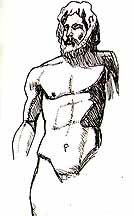
Peggy's Poseidon
|
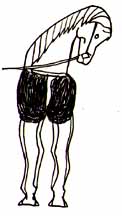
|
Suddenly it’s over. There’s just a hint of rise and fall to the
road, like the bedclothes on a sleeping child. Liveoak-shaded
pasturelands full of cattle and egrets. The longleaf pines rise
up again, and we’re in Central Florida. Signs advertising tack
and cowboy gear. Hype for a county fair. And the familiar signs
of rural civilization: lawn ornaments. A custom mailbox outlet,
with a row of wickedgood concoctions out front. A monumental cypress
butt carvatoria, with hideous manatees and pelicans. And cut-signboard
yardart clustered in front of shaded bungalows. |
| We’re back in the latitudes of DeLeon Springs, where crystal waters
gush out of limestone depths and run in sparkling rivers to the
sea. It hasn’t been totally trampled yet, and the breeze today
makes it like a July evening at home. Wildflowers are running
rampant on the margins of Rt. 19, and blooming trees sweeten the
air. The Owl glides into Homosassa Springs, and comes to rest
alongside a state wildlife refuge. Manatees in the morning. |
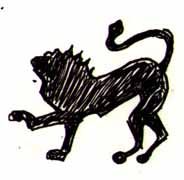
|












